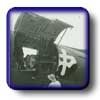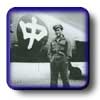Southeast Asia
 In
the spring of 1944, the Allies
had the Japanese on the defensive in Burma. The Japanese
had failed to find an adequate way of maintaining logistical
support to troops deep in arduous territory. The Allies
now faced this same logistical problem. In
the spring of 1944, the Allies
had the Japanese on the defensive in Burma. The Japanese
had failed to find an adequate way of maintaining logistical
support to troops deep in arduous territory. The Allies
now faced this same logistical problem.
The solution lay in air transport. Unfortunately, there
was a shortage of aircraft. Royal Canadian
Air Force (RCAF) Squadrons 435, 436 and 437 were
 formed
in order to boost these numbers. Their base was at Gujrat
in present-day Pakistan, and where they faced a shortage of
provisions, including medicine and aircraft maintenance equipment. Despite
the scarcity of provisions, Squadrons 435 and 436
managed to carry out necessary modifications to their
Dakota aircraft by
November 1944, after which they moved to Tulahil in the
Imphal Valley in order to support the advance of Sir
William Slim and the Fourteenth Army. formed
in order to boost these numbers. Their base was at Gujrat
in present-day Pakistan, and where they faced a shortage of
provisions, including medicine and aircraft maintenance equipment. Despite
the scarcity of provisions, Squadrons 435 and 436
managed to carry out necessary modifications to their
Dakota aircraft by
November 1944, after which they moved to Tulahil in the
Imphal Valley in order to support the advance of Sir
William Slim and the Fourteenth Army.
There were two methods of delivering cargo. The preferred
was to land and unload. This proved problematic, as the
airstrips were often precarious and rudimentary. Heavy loads
also led to flat tires.
 The other method was to make drops, either free drops or
with parachutes attached. Pilots had to circle low, leaving the aircraft
unprotected against fire
from the ground. The Dakotas were also vulnerable to air
attacks. They had little defences of their own beyond
"knock-out" holes in the windows for rifles, and were rarely accompanied
by fighters for protection. At this point in the war the
Japanese were mostly using their air power to support their
land forces. One attack on the supply aircraft, however,
left two Dakotas The other method was to make drops, either free drops or
with parachutes attached. Pilots had to circle low, leaving the aircraft
unprotected against fire
from the ground. The Dakotas were also vulnerable to air
attacks. They had little defences of their own beyond
"knock-out" holes in the windows for rifles, and were rarely accompanied
by fighters for protection. At this point in the war the
Japanese were mostly using their air power to support their
land forces. One attack on the supply aircraft, however,
left two Dakotas
 destroyed and six airmen dead. destroyed and six airmen dead.
Rangoon was captured on May 3, 1944 after which the transport
squadrons continued to operate, bringing food to local populations
and supporting continued fighting in other parts of Burma.
After the war in the Pacific was over, the squadrons
conducted postwar operations in Northwest Europe.
 During their time in Southeast Asia, the three squadrons
racked up flying hours far beyond the norm, through terrible
weather and inadequate facilities, maintaining a level of
serviceability near 90 percent. This was a phenomenal rate given the conditions
the crew were dealing with. Slim commented that "the heroes
of this time were the men who kept the wheels turning and
the wings flying." During their time in Southeast Asia, the three squadrons
racked up flying hours far beyond the norm, through terrible
weather and inadequate facilities, maintaining a level of
serviceability near 90 percent. This was a phenomenal rate given the conditions
the crew were dealing with. Slim commented that "the heroes
of this time were the men who kept the wheels turning and
the wings flying."
Squadron
413, formed in Stanraer, Scotland in July,
1941, was also deployed to Southeast Asia, as part of the
anti-submarine war. Flying Catalinas their
job was to patrol the vast Indian Ocean in search of Japanese and
German forces.
 The squadron flew its first patrol on March 31, 1942. On April
second, Squadron Leader L.J. Birchall arrived. Two days later, he
flew one of the most significant missions of the war. Flying 350
miles from Ceylon, Birchall was about to turn homeward, when he
spotted a Japanese flotilla luring on the sea. Birchall banked
towards them while his radio man sent a message to Ceylon, warning
them of the impending Japanese attack. The squadron flew its first patrol on March 31, 1942. On April
second, Squadron Leader L.J. Birchall arrived. Two days later, he
flew one of the most significant missions of the war. Flying 350
miles from Ceylon, Birchall was about to turn homeward, when he
spotted a Japanese flotilla luring on the sea. Birchall banked
towards them while his radio man sent a message to Ceylon, warning
them of the impending Japanese attack.
The Catalina was attacked by the Japanese within minutes, crash
landing in the water. Eight of the nine crew made it into the water.
Subsequent strafing killed two more crewmembers, and three were
badly wounded. All the survivors, including Burchall, were taken
prisoner. Ceylon, however, was alerted to the Japanese fleet in time
to repulse the attack. Birchall was henceforth called the
"Savior of Ceylon".
 Other than that, the Japanese were largely absent, and aside
from once getting shot at by an errant RAF plane (which
killed one crewmember) patrolling the vast Indian Ocean
was uneventful. The 413 Squadron made four attacks on
submarines during their time there, none of which were successful. Other than that, the Japanese were largely absent, and aside
from once getting shot at by an errant RAF plane (which
killed one crewmember) patrolling the vast Indian Ocean
was uneventful. The 413 Squadron made four attacks on
submarines during their time there, none of which were successful.
Royal
Canadian Air Force pilot and Squadron Leader Edward Bryce
Chase flew transport planes in Burma, among other tasks in
Southeast Asia.

 |
 Heritage Community Foundation Presents
Heritage Community Foundation Presents Heritage Community Foundation Presents
Heritage Community Foundation Presents